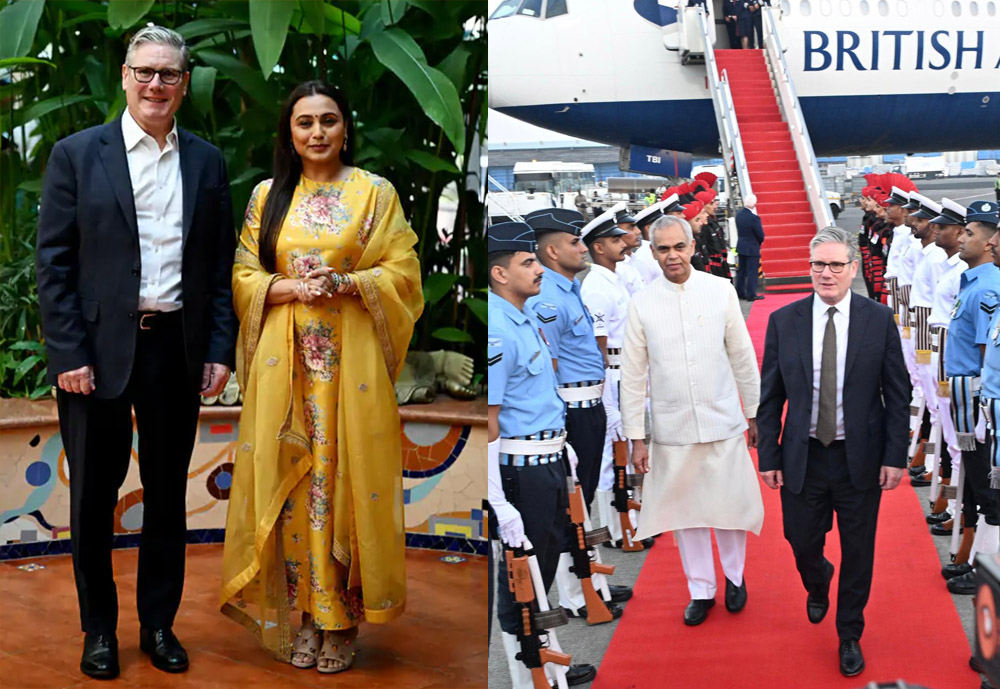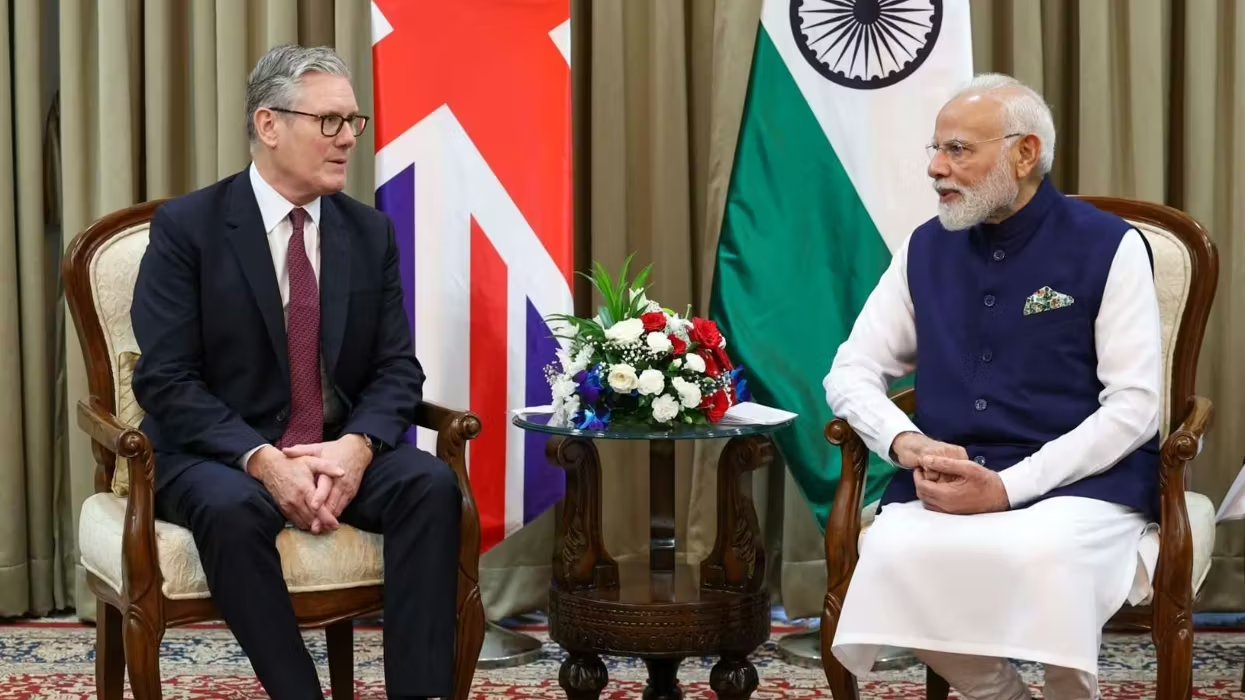When UK Prime Minister Keir Starmer visited India in October 2025, the trip carried strong symbolic and strategic weight. It was his first official visit since assuming office, and it followed the signing, earlier in 2025, of a much-anticipated Comprehensive Economic and Trade Agreement (CETA) between the UK and India. In many media accounts, Starmer described that trade deal not as a mere legal document, but as a “launchpad for the future.”
That phrasing captures not only optimism, but also a vision of how the trade pact is intended to serve as a stepping stone—catalyzing deeper cooperation across trade, investment, education, technology, defense, and more. His meeting with Prime Minister Narendra Modi in Mumbai aimed to transform rhetoric into action, to underscore commitments, and to set in motion the next phase of what both countries call a “modern partnership.”
In what follows, we explore the background of the deal, what Starmer meant by “launchpad,” what was discussed during the Modi meeting, and what opportunities and challenges lie ahead.
Background: The India–UK Trade Agreement (CETA / FTA)
The Road to Agreement
-
Negotiations between India and the UK formally began in January 2022, following the UK’s exit from the European Union and its desire to establish new independent trade ties.
-
Over the course of about three years, the talks faced multiple sticking points—especially on visas and mobility, tariff cuts on sensitive goods (such as whisky, cars, pharmaceuticals), and market access in services.
-
On 24 July 2025, the two countries signed the agreement in London, marking a landmark moment.
-
The agreement is often characterized as the most significant trade deal the UK has signed post-Brexit.
Key Provisions and Promises
While the full text and all implementation details are not always public, some of the major features are better known:
-
Tariff reductions / elimination: The agreement promises to slash or remove tariffs on a wide range of goods. For example, whisky tariffs in India would drop sharply—initially from 150% to 75%, and then further reductions planned.
-
Market access for services: The deal aims to enhance access for UK services companies into India (e.g. education, finance, digital) and vice versa.
-
Business mobility / limited movement provisions: While visa liberalization was a topic of negotiation, the final agreement reportedly does not include major new visa concessions. Starmer explicitly stated the UK “will not seek a visa agreement” during his visit.
-
Implementation timeline: The goal is to ratify and bring the deal into effect within about a year from the time of the visit.
-
Ambitious trade targets: The two nations hope to more than double their bilateral trade by 2030, from current levels (~USD 56 billion) to ~USD 100 billion or more.
Thus, when Starmer called the deal a “launchpad,” he was referencing this agreement as the foundational platform from which further cooperation and growth could stem.
Starmer’s Visit: Mumbai, Modi, and the “Launchpad” Language

Arrival and Symbolism
-
Starmer’s arrival in Mumbai was greeted as a historic visit, with India welcoming the UK prime minister and highlighting the largest-ever UK trade delegation accompanying him.
-
The Indian side framed it as a reaffirmation of shared vision and growing ties. Modi posted, “Welcome Prime Minister Keir Starmer on your historic first visit to India with the largest ever trade delegation from the UK…”
The “Launchpad” Framing
Starmer, in public statements, presented the trade deal as more than a legal agreement:
“It’s not just a piece of paper, it’s a launchpad for growth.”
“Opportunities waiting to be seized are unparalleled.”
He also noted that India is projected to be the third largest economy by 2028, and that with the trade deal, trade between the two nations would become “quicker and cheaper.”
By using that phrasing, Starmer sought to convey optimism, momentum, and a sense of long-term commitment rather than short-term transactionalism.
The Modi Meeting & Joint Agenda
During the bilateral meeting and associated events, several key themes and announcements emerged:
-
Economic and Trade Cooperation Expansion
-
Both leaders emphasized deepening trade ties, increasing market access, and accelerating implementation of the FTA.
-
Modi referred to the deal as “path-breaking,” stating it would create jobs, benefit industries and consumers, and expand trade linkages.
-
In the India-UK CEO Forum held in Mumbai, Modi and Starmer set targets and roadmaps for shared progress, including aiming to hit USD 100 billion bilateral trade by 2030.
-
-
Education & Cultural Exchange
-
A notable announcement was that several British universities — including Lancaster and Surrey — would open campuses in India. This move is seen as a way of deepening people-to-people ties and institutional cooperation.
-
Starmer also linked the trade deal to boosting the UK’s role as a partner in technology, research, creative industries, and education.
-
-
Defense and Technology Collaboration
-
One concrete outcome was the UK’s agreement to supply India with missiles from Thales (Northern Ireland), valued at ~£350 million.
-
Additionally, the visit featured signing of a naval collaboration agreement on electric-powered ship engines, further cementing strategic ties.
-
Technology security, critical minerals, digital infrastructure, AI, and collaboration in defense innovation were also part of the joint communiqué.
-
-
Global & Strategic Issues
-
Starmer called for India’s inclusion as a permanent member of the UN Security Council, marking the UK’s support for India’s global role.
-
Conversations also covered global challenges — Ukraine, West Asia, climate, energy, Indo-Pacific security, and multilateral cooperation.
-
Modi and Starmer used the opportunity to underline their alignment in democratic values, governance norms, and strategic stability.
-
-
Trade Implementation, Timelines & Delivery Mechanisms
-
Both sides signaled urgency: Starmer called for the FTA to be implemented “as soon as humanly possible.”
-
To support delivery, India and UK agreed to reconstitute the Joint Economic and Trade Committee (JETCO) as a mechanism for oversight and institutional coordination.
-
The British delegation accompanying Starmer included over 100 business, academic, cultural, and technological leaders (from companies such as BP, Rolls-Royce, BT, Diageo) to maximize private sector engagement.
-
All of this indicates that the meeting with Modi was not only about headline photo-ops, but about laying groundwork to operationalize the “launchpad” that Starmer spoke of.
Interpreting the “Launchpad” Metaphor
Why did Starmer use the term “launchpad for the future,” and what does it signal?
-
Beyond a Trade Pact—Foundational Platform
A launchpad is a starting point. Starmer wants to emphasize that the trade agreement is not an end in itself, but the base from which broader cooperation can be launched. In his view, this is a beginning—of deeper integration in multiple sectors. -
Signaling Momentum and Ambition
Use of the word “launchpad” carries forward-looking energy. It asserts that the momentum from the signing needs to be harnessed quickly. It is a call for speed, for moving from promise to praxis. -
Holistic Partnership, Not Only Commerce
The metaphor suggests a broader trajectory: education, technology, defense, mobility, cultural exchange, institutional ties. The trade deal enables those further ambitions. -
Credibility & Confidence Building
In trade diplomacy, words matter. Calling it a launchpad is a rhetorical move to boost confidence among investors, businesses, universities, and policymakers—signaling that the UK is serious about leveraging the pact, not letting it sit idle. -
Reassurance to Domestic Audiences
For UK audiences, Starmer is under some pressure: delivering growth, exports, reversing economic sluggishness. Saying this deal is a launchpad helps frame it as a tool for jobs, innovation, and prosperity at home. For India, it reassures that the UK sees India as a strategic partner for the long run.
Opportunities Created & Strategic Benefits

If successfully executed, the “launchpad” vision would yield gains across multiple fronts:
Economic & Trade Gains
-
Export growth: UK firms in sectors like automotive, machinery, medical devices, consumer goods can access Indian markets more competitively.
-
Import diversity: Indian exports—textiles, jewelry, food products, spices—can access the UK with fewer tariffs.
-
Trade expansion: Meeting the target of ~USD 100 billion bilateral trade by 2030 is ambitious but plausible, especially in areas like digital services, chemicals, pharmaceuticals, and creative industries.
-
Investment flows: The agreement is likely to stimulate bilateral investments, joint ventures, and cross-border mergers & acquisitions.
Knowledge & Education Links
-
British universities establishing campuses in India can promote joint degree programs, research collaboration, student mobility, and capacity building.
-
Academic exchange and research partnerships can deepen, especially in areas like climate science, AI, biotech, green energy, and health.
-
The educational dimension also builds soft power, cultural affinity, and people-to-people links.
Technology, Innovation & Strategic Collaboration
-
Defense and security cooperation (e.g. missile supply, engines, dual-use technologies) provides a basis for strategic integration.
-
Collaboration in digital infrastructure, cybersecurity, fintech, clean energy, and critical minerals can become new pillars.
-
India’s strong IT base, entrepreneurial ecosystem, growing AI/tech sector, and large market offer complementary strengths to UK capabilities.
Geopolitics & Influence
-
The UK positioning itself as one of India’s closest Western partners helps it remain relevant in Asia in a post-Brexit order.
-
India gains credibility by deepening links with a major European power, strengthening its global footprint.
-
Alignments on global issues: climate, Indo-Pacific strategy, multilateral institutions, and reforms (like UN Security Council reform) gain more collaborative weight.
Jobs, Growth, Stability
-
A successful execution can generate employment in manufacturing, services, R&D, and education sectors in both countries.
-
Firms would benefit from supply-chain integration, economies of scale, and deeper market access.
-
Reduced tariff uncertainty and regulatory clarity can boost investor confidence and reduce friction.
Risks, Challenges & Caveats

The “launchpad” vision is ambitious, but it is not without risks and potential pitfalls.
-
Ratification & Implementation Delays
International agreements often stall in legislative or regulatory processes. Any delay in ratification or in aligning domestic laws could dampen momentum. -
Non-Tariff Barriers
Many trade frictions are non-tariff in nature: standards, certifications, regulatory divergence, local content rules, customs procedures. Overcoming these can take time and diplomacy. -
Visas & Mobility Constraints
Though the final agreement did not include large visa concessions, if businesses demand greater mobility, the lack thereof could become a bottleneck. Starmer has already ruled out pushing for visa liberalisation with India in this round. -
Political Opposition / Domestic Pressure
In both countries, critics might argue the agreement favors one side, or jeopardizes certain industries. Adjustment pressures (e.g. to weaker domestic players) could spur backlash. -
Expectations vs Reality
If high expectations are set (as “launchpad” language suggests), failure to deliver visible gains swiftly may result in disillusionment. The optics become as important as substance. -
Global Trade Headwinds
Rising protectionism globally, supply chain disruptions, currency fluctuations, and geopolitical tensions could hamper trade flows. External shocks (e.g. global recession, commodity price spikes) may derail plans. -
Translation into Domestic Growth
Even if trade expands, ensuring local manufacturing, job creation, upskilling, and equitable distribution of gains is a nontrivial task. The benefits must reach ground level, not only elite sectors. -
Strategic Risks & Sovereignty Concerns
Some critics may argue defence or technology cooperation may raise sovereignty, security or strategic dependency issues. Oversight, transparency and alignment of interest will be essential.
Assessing the Modi–Starmer Meeting’s Success
Given these opportunities and challenges, how well did the meeting serve its intended purpose?
-
Strong symbolism and ambition: The presence of the large UK business and research delegation, the high-profile announcements (e.g. missile deal, universities in India) reinforce seriousness.
-
Concrete early wins: The missile supply agreement and naval engine deal suggest the partnership is not purely aspirational.
-
Institutional follow-through: Reconstituting JETCO, aligning trade committees, and signaling a delivery focus reflect a desire to build operational structures.
-
Diverse agenda: By going beyond trade—into education, technology, defense, global diplomacy—the meeting underscored the “bigger than commerce” approach.
-
Cautious pragmatism: On visa issues, Starmer opted to avoid overpromise; that tempered expectations and reduced friction.
Where the meeting may be tested is in execution—whether promises turn into scalable projects, whether trade flows accelerate, and whether systemic frictions are resolved.
What to Watch Going Forward
To evaluate whether the trade deal becomes the “launchpad” Starmer envisages, observers should monitor:
-
Ratification timeline: How quickly both parliaments or regulatory bodies approve the agreement.
-
Trade flow data: Quarterly and annual stats showing export/import growth and shifts in trade balance.
-
Investment announcements: New joint ventures, FDI flows, R&D centers established.
-
Education projects progress: Whether the announced UK campuses in India come up, and how quickly they recruit faculty, students, and research programs.
-
Technology / defense contracts: New contracts beyond the initial missile and engine deals.
-
Regulatory alignment work: How India and the UK address standards, customs, intellectual property, digital governance, environmental clauses, and market access.
-
Sectoral outcomes: Which sectors benefit (automotive, textiles, pharma, tech) and which struggle or object.
-
Public perceptions: How citizens, businesses, and media in both countries view the impact (job creation, price changes, economic confidence).
-
Geopolitical effects: How the India–UK partnership influences regional balances—especially in Asia, the Indo-Pacific, and with other trade blocs.
-
Continuation of diplomatic engagement: Visits, summits, ministerial exchanges, and fresh collaborative agreements.








